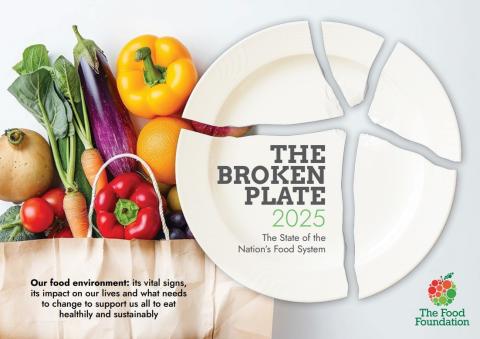25 February 2025
Why healthy and affordable diets are out of reach for many

The Food Foundation's Head of Policy and Advocacy Dr Hannah Brinsden and Professor Jean Adams, Professor of Diet & Public Health at the MRC Epidemiology Unit in University of Cambridge, examine the true cost of healthy eating
In this year’s Broken Plate report we calculated again the proportion of disposable income which different households would need to spend to afford the costed version of the government’s Eatwell Guide (£9 per person per day).
We found that for the lowest income households, the government’s recommended healthy diet would cost at least 45% of their disposable income, rising to 70% in those with children.
This is unrealistic for many. The government’s data on household food expenditure shows that the poorest 10% spent £4.04 per person per day on food and drink in 2021/22 (the most recent data available), far less than £9 per day (2024 cost).
It is not surprising, therefore that 13.6% of households are currently affected by food insecurity (where they are skipping meals, not eating etc), a figure that’s even higher amongst vulnerable groups including disabled people and those with mental health conditions.
This tells us that for large parts of the population, accessing affordable food that keeps people and their families feeling full and well - nourished is a daily battle.
Research carried out by The MRC Epidemiology unit at the University of Cambridge published in this year’s Broken Plate report found that healthy food is, on average, more expensive than unhealthy food, calorie-for-calorie.
More worryingly still, the gap has widened over the last two years meaning healthier options, as defined using nutrient profiling, are becoming increasingly out of reach for many.
The data showed, for instance, that the cost of a cucumber has gone up by 45% between 2022 and 2024, the cost of frozen pre prepared veg has gone up by 38%, the cost of frozen peas has gone up by 33% and the cost of an iceberg lettuce has gone up by 45%.
It is important that producers of fruit and veg receive a fair price, that household incomes are sufficient to afford these nutritious foods, and that the most affordable options are the most nutritious to enable healthy choices.
The MRC Epidemiology Unit published a peer-reviewed paper last year using the same methodology.
The research draws on established methodology which looks at a basket of commonly purchased food and drink that is tracked as part of the Government’s Office for National Statistics’ Consumer Price Index (CPI).
This is what is used to monitor food inflation. For each item, price per 1000kcal was calculated using energy and nutritional data in the National Diet and Nutrition Survey, and then each item was classified as healthy or less healthy, using the government’s nutrient profiling model.
Less healthy foods are those with high levels of fat, sugar or salt. These are the food and drinks that can’t be advertised to children on TV.
It is possible to examine the affordability of food in different ways depending on the question you want to answer, whether by comparing prices per portion, by weight or by calories.
In all of these cases, conclusions will be based on averages and it will always be possible to find examples of individual items that are healthy and cheap, and less healthy items which are expensive.
This doesn’t, however, negate the finding that, on average the commonly consumed healthier foods in the Consumer Price Index basket are more expensive than the less healthy ones calorie-for-calorie.
The Food Foundation’s annual Broken Plate report takes stock of the food system and the food environments we live in, focused on areas where government intervention can improve public health.
With this in mind, comparing the affordability of healthy and less healthy food is best done by comparing calories as it gives us a good picture of the quality of diets, and the sustenance that is provided by foods.
Other measures are more useful when trying to identify potential substitutions that can be made and exploring consumer choices (This paper provides a good description for different methods and their respective applications).
In addition to the cost of different foods, there are other factors which affect the foods which people can afford.
They may be concerned about waste, fuel bills or have limited kitchen facilities to prepare or store food (many households don’t have freezers) which make cheap pre-prepared meals a better and more affordable, but less healthy option.
Time to prepare meals from scratch is also an important consideration, particularly for low-income households who may have multiple jobs, or unpredictable work hours, and significant caring responsibilities on top of work.
The area we live in also makes a big difference to the food that is available to us, with many deprived areas being ‘food deserts’ where affordable fruit and veg is at least a bus ride away.
The disparity in price between healthy and unhealthy foods, and the fact that this gap is widening is deeply concerning and, it is just one indicator that our food system is not currently serving our citizens well.
This highlights the need for interventions that shift the incentives in the system and make the healthier options the most affordable options for everyone.
Interventions could range from expansions of both the Healthy Start scheme and Free School Meal provision, through to minimum wage and benefit levels that ensure everyone can afford a healthy and sustainable diet, or taxes on food manufacturers that help incentivise production of a healthier, more affordable food supply for all.
More details of the Food Foundation’s policy asks are here.

Hannah joined the Food Foundation in May 2023 as the Head of Policy & Advocacy. She oversees our portfolio of policy and Government engagement activities. Prior to joining us, Hannah worked at the World Obesity Federation for over 10 years where she worked across a range of issues including childhood obesity, food systems and healthcare. She also previously worked at Consensus Action on Salt and Health as a Nutritionist, leading on product surveys. Hannah has an undergraduate degree in Nutrition and Food Science from The University of Reading and a PhD in Food Policy from City, University of London which explored the role of NGO advocacy in UK nutrition policy.

Jean Adams is a Professor of Dietary Public Health at the MRC Epidemiology Unit at Cambridge University. Her work explores how the environment, in its widest sense, influences what people eat and how we can change the environment to support people to eat better. Recent work has explored online food delivery apps, menu labelling in large chain restaurants, the soft drinks industry levy and the potential for ‘healthier’ takeaways.




